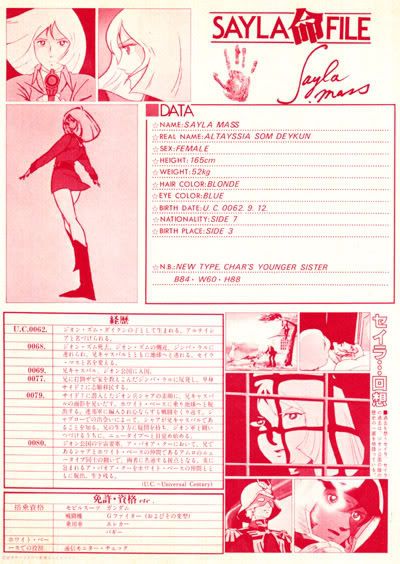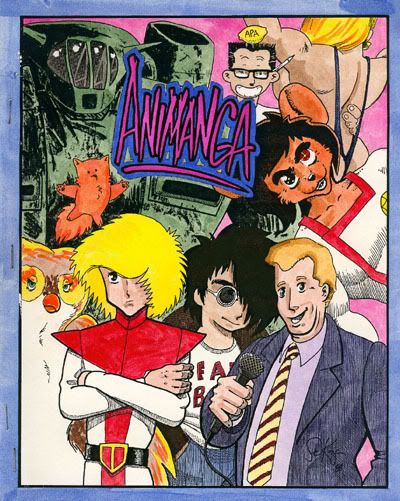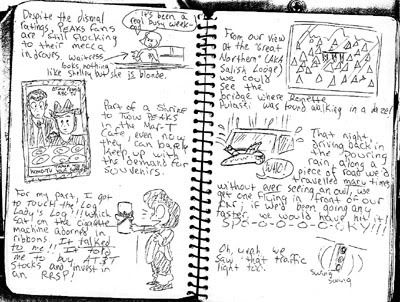(This article originally appeared in LET'S ANIME #4, Fall 1993)Make Mine MOMO!
Why I watch FAIRY PRINCESS MINKY MOMO
by Ed Hill
Ever since I went to my first convention and contracted that inexplicable fondness for the products of anime culture ('twas at the July 1988 Dallas Fantasy Fair, for the insatiably curious), I've met countless others with the same tastes, absorbed a lot of video, and even made the crossover into the ranks of would-be creators of the stuff. So I am not here to excoriate everything about so-called "fandom"; hell, i'd be shooting myself along with my targets. Besides, I can do that later.
Nope, what I'm here to do is take Dave up on a statement he made in the last issue, an editoral where he said he'd even run an article about the show
FAIRY PRINCESS MINKY MOMO if anybody sent it in. Now, considering that I really dig this show, I figured that an article on it would be really cool, and that this was a golden chance for somebody to get one published. However, also knowing the taste and the cretinous nature of the dominant fanboy herd, it also occured to me that I was that somebody. So I sat down to write this splendid retrospective on the wonders of FAIRY PRINCESS MINKY MOMO (for convenience's sake, hereafter to be referred to as "MOMO").

However, I ran into a brick wall - there exists no translated episode guide that I know of, episodes themselves are hard to find, and few people even considered translating the stuff that made it over here. This makes it rather impossible to write up something for it as worthy as the DEVILMAN or MAZINGER Z articles that have appeared in this magazine. So, I fudge a bit - herein, I offer some of the reasons that I say "Make mine MOMO!" - and why you should, too.
I have to admit my fascination with the whole thing started as a desire to be different. I got to hanging out with a rather scurvy lot of fans not long after I was introduced to anime. And since these were the guys I got most of my stuff from, most of it reflected their tastes. This meant that they mainly had lots of GUNDAM, lots of BUBBLEGUM CRISIS, and an extensive CREAM LEMON stash. Generally their attitude (like that of most fans these days) was that anything with a recent copyright date was good, old was bad, and if it didn't have cute girls with guns in it, they had no time for it. One day, they commenced to ragging on various things they hated - amongst them were the works of Hayao Miyazaki, Reiji Matsumoto, and anything Takahashi did before RANMA 1/2, as I recall.
But the show that seemed to bug them the most was something called
MINKY MOMO. They thought it was the worst of them all. Now, since I happen to be somewhat contrary in nature, I figured that since they hated it, I ought to check this show out. After all, the other stuff they despised was really very good! So eventually I found some Momo episodes on an ancient tape of some other crap that a friend had, and gave it a watch. I thought that maybe even those geeks could be right about this one show - the name certainly wasn't encouraging! But, did you know, this MOMO was surprisingly good. and thusly did I become the unapologetic fan that I am today. As for reasons why I say this, just keep reading...

First, I like the show because it's cute. Yes, cute. What's wrong with that, fanboy? There is a dread of the word 'cute' these days, and it's a damned shame. Cuteness is not bad in and of itself! It can be whimsical and fun - "cute" doesn't have to mean drippy and smarmy
Care Bears or Rainbow Brite nonsense. At best it can be a reminder of happier times, of affection and good things. MOMO is cute, but not TOO cute. Besides, cute is always harder to take when it's accompanied by a moral, like in American cartoons. MOMO is not afflicted by any heavy, preachy "message." Sure, she goes about helping to fulfill dreams, but you never feel as if you learned anything from it! And some of the things she does, though minor, would be roundly condemned by parents and teachers alike in America. For example, to help a boy whose father is a jewel thief, she becomes the Red Cat and gets into a stealing contest with the guy! In a racing episode she mercilessly runs a fellow driver off the road and into a river. And there's the hilarious "Minky Rambo" scene from the opening episode of the second '91 MOMO series. Trust me, it's cute, but not wussy cute!

Secondly, the show is quite funny and sports the occasional gonzo touch as well. There are jabs at other anime shows - the Red Cat episode takes pokes at LUPIN III, the racing episode was packed with SPEED RACER gags, and there are many others. The opening idol star number of the
Minky Momo film "La Ronde In My Dream" features hilarious imitations of MACROSS' Minmay, MEGAZONE 23's Eve, and others. Also in the film Peter Pan and Slim Pickens' DR STRANGELOVE character Major "King" Kong show up quite a bit! And for the final perverse touch, why not consider the infamous ending of the first MOMO series, way back in '83? For those who don't know, here's the story. She's nearly completed her mission on Earth; one more dream fulfilled and the last jewel on the Magic Crown will be in place and the Dream Land of Phenarinartha will come back to Earth and everything will be groovy. Happy ending, right?
Well, no. Momo loses her magic pendant - without its protection, she's as vulnerable as any other Japanese schoolgirl - and then she's SPOILER WARNING killed in a tragic car wreck! Her spirit then chooses to hang around Earth and wait to be reborn. Now is that a hell of a way to end a kids show, or what? No matter what you think of the rest of the series, you have to hand it to anybody with the balls to wrap it up like that, eh? How many of the current wretched crop of OVAs out today have as much grit
as this supposedly sickeningly-sweet children's program? Not very many, as I see it...

Thirdly, although you can't exactly accuse the show of being overburdened by complex plot structures, I see that as a good thing! Sure, it verges on dumbness sometimes, but even when the show is dumb, it is that good, lighthearted kind of unpretentious dumbness that makes it all fun. For, above all, it's a fun show at heart. So what if there aren't any MOMO technical or resin giant robot model kits - I find the fan desire to "explain" every detail really tiresome! And besides, it being a kids' show makes it easier for the untutored gaijin to figure out what's going on without help. My personal opinion is that Momo is like your favorite toy from childhood - your affection for it may not have been entirely rational, but you loved the thing anyway, didn't you?
And before you start squawking that MINKY MOMO was meant for girls, consider this - anime itself, in every sense, was not made for ANY of us! It was made for a Japanese audience with a different culture and language and different tastes. They never even considered American anime fans into the equation at all! Whether you watch "boys" or "girls" or "adult" anime, nobody is going to think you any less strange. Do you think the Japanese will condemn you for watching one thing but approve of you watching another? Quite frankly, they don't care. Most of them have no idea anybody else from any other country watches their cartoons, and the ones that do will find it odd whether you watch MOBILE SUIT GUNDAM or MINKY MOMO.This doesn't mean that you shouldn't watch it, of course - what I'm trying to say is that since you're an outsider no matter what, why not just go ahead and reach for that forbidden fruit? Watch MINKY MOMO - you have no reputation to lose! Well, maybe your nerd friends will talk smack about you. But who cares what that gang of Priss-worshipping no-lifers thinks anyway?

(note heavy metal hand gesture - ROCK ON MINKY MOMO!)
I'll be the first to admit that I can't explain every reason why I watch MINKY MOMO. It's like beer, I guess - an acquired taste. But I hope at least I came up with a few good reasons as to why you might spend a bit of time with the show. It has heart, it's cute, and it's funny - what more do you really need? Besides, if you have a thing for pink hair, this is the show for you! So, until next time kids, remember -- "Pipuruma, Pipiruma, Purilinpa! Papareho, Papareho, Dorilinpa!!"
Ed Hill is a cartoonist residing in Arlington Texas. He's noted for his strip FAIRY PRINCESS YUKIO MISHIMA and for singing the MINKY MOMO theme song at karaoke events.








































